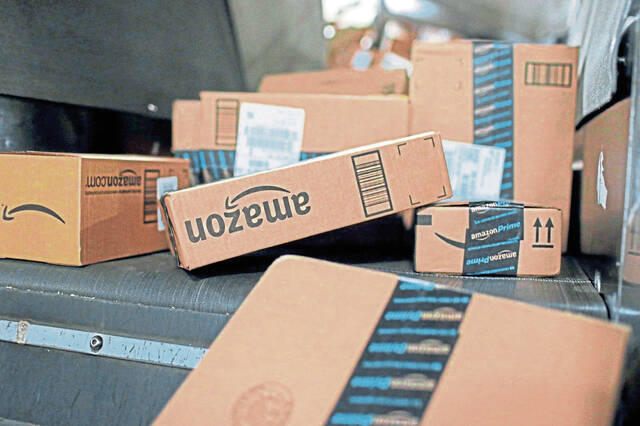If the sight of over $4.30 a gallon for regular gasoline is cringeworthy, imagine $5.50 — or more — and having to fill a 150-gallon tank.
Warren Horton has faced such a dilemma recently, including Tuesday when he stopped in Western Pennsylvania to fuel his big rig hauling a stacked vehicle carrier from the Baltimore port to dealerships in Pennsylvania, Tennessee, Ohio and other states.
“It’s hard. Last week, I paid $846 to fill it up,” said Horton, 63, of Pittsburgh outside the Pilot Flying J truck stop off the Smithton exit of Interstate 70. During that stop, he paid just shy of $820 for 141 gallons, or $5.80 per gallon.
Horton said he usually fills up anywhere but Pennsylvania because the fuel taxes here are so high — 75 cents per gallon for diesel.
That fuel money comes straight from Horton’s Flying J credit card, not a company gas card, as he is an independent driver who drives his own truck.
Diesel fuel sold for $2.18 per gallon, on average, last March in the central Atlantic region, which includes Pennsylvania. That price climbed 150% to an average of $5.47 a gallon this March, according to data from the U.S. Energy Information Administration.
Trickle down
The higher cost that independent truckers and transportation firms pay does not impact only them. It filters down to consumers in the form of higher prices and has been doing so since last year, said Rise Kumazawa, an associate professor of economics at Duquesne University in Pittsburgh.
With so many goods being moved across the nation by trucks, the higher prices consumers are paying becomes “part of the cost of production,” Kumazawa said.
Nowhere on the horizon does there appear to be a quick drop in prices for fuel or other products, Kumazawa said.
Related:
• How high will gas prices go?
Owners of two local supermarket chains also see no relief, either in a near-term drop in fuel prices or for fuel surcharges.
Such surcharges recently climbed as high as $400 to $500 a week from a Nashville, Tenn.-based grocery supplier, said Bill Naser, owner of Naser Foods stores in Oklahoma Borough and Pleasant Unity. He started seeing fuel surcharges about nine months ago, then a product of inflation. Russia’s invasion of Ukraine has only exacerbated the problem.
Grocers in the best of times operate on slim profit margins, Naser said. They cannot absorb extra charges in the worst of them. When the fuel surcharge was raised, Naser said he did not learn until after the groceries were delivered to his stores and he was billed for the products.
“We’ve had to raise prices,” Naser said.
The price increase varies from product to product and is not spread evenly. That’s not so for locally sourced produce and meat, which have a minimal fuel surcharge of $3 or $4 per delivery, if any increase at all.
Tom Charley, whose family owns two Shop ’n Save supermarkets in Greensburg and another in Murrysville, said they so far have absorbed fuel surcharges, which can amount to thousands of dollars a month for the three stores.
“We don’t add to the cost (of goods) unless the supplier raises the price,” Charley said.
Fuel surcharges started hitting his stores about six months ago, Charley said. It has become a cost of doing business, squeezing that slim profit margin.
M&M Trucking, a Unity firm, has been able to add a fuel surcharge even though it is operating in a competitive environment, Julie McFeaters said. Her husband, Tim, owns the business that ships products up and down the East Coast.
“Our customers understand. It’s the industry trend,” said McFeaters, whose company hauls steel, titanium and lumber.
They are not immune to price hikes at the pump. Unlike larger trucking companies that may maintain fuel tanks and be able to ride out price spikes, McFeaters said her company pays at the pump.
Adding to fuel prices is the increase in wages for truck drivers, which raises transportation costs, Charley said.
Naser said he recently received a notice from his Tennessee wholesaler that it was adding to the base price of a trailer of goods because the company had to raise wages to attract drivers in a time of a national shortage of truckers and other workers.
“That is wage-inflation,” Naser said.
ECM Transport of West Deer has slapped a fuel surcharge on its shipments that amounts to about 72 cents a mile, up from 45 cents a mile last fall, said Scott Huss, load planner for the trucking firm that has a fleet of 475 tractors that haul products ranging from cans of groceries to coils of steel. That fuel charge, transparent to customers, can change on a daily basis, depending on the rise and fall of the price of diesel, said Huss, who has been in the trucking business for 21 years.
But not all firms using diesel-powered trucks have added a fuel surcharge as the fuel price has risen.
Glassmere Fuel of West Deer has not added a surcharge when it delivers home heating oil to its customers, said Dave Talmage, operations manager for the firm.
Covid impact
Like so many other aspects of life over the past two years, the rise in diesel prices can be blamed, in part, on how covid-related restrictions slammed the oil industry, said John Eichelberger, executive director of the Fuel Institute, an Alexandria, Va.-based research agency founded by the National Association of Convenience Stores.
The pandemic caused the oil industry to rein in production and refinery operations, Eichelberger said.
As people were forced to stay at home and businesses shuttered in spring 2020, the price of crude oil plummeted. In April 2020, the price of West Texas crude oil fell below $0, meaning producers had to pay to get rid of it, Reuters reported.
That was “the kick in the gut,” Eichelberger said.
Crude oil prices traded around $105 a barrel at the end of the week, which was a 47% hike from its post-Thanksgiving price of $68, according to the Crude Oil Price website.
Crude oil accounts for around half of the cost of both gas and diesel.
When the economy started to recover and consumer demand rose, oil production did not return as fast as the pace of consumption, Eichelberger said. The rise in consumer demand came at the same time as air travel rebounded, so some production increase went to making jet fuel, he said.
U.S. production of fuel from crude oil has been well below average since the start of the year, according to the Energy Information Administration. The attack on Ukraine also particularly impacted the already low distillate inventories because Russia is a large supplier of crude oil to Europe, along with a much smaller amount to the U.S., the federal agency said.
“You have high crude oil prices, and you have limited diesel supplies — both are putting upward pressure on prices,” EIA analysts said in a statement.
The cost of fuel will drop this year and into 2023 as production rises to meet demand, the EIA forecasts. Diesel prices will average $4.04 per gallon for the second half of this year, then drop to around $3.80 per gallon in 2023, the EIA predicts.
But Lenny Rodriguez, an arbitrage and Latin America oil analyst for S&P Global Commodity Insights, says his crystal ball does not offer as clear of a glimpse of future diesel prices.
Even though diesel prices have come off the very high levels of last week, they remain very strong and ahead of gasoline, Rodriguez said.
“When will this be corrected? It’s unpredictable. It will largely depend on the duration of the war, its impacts to diesel trade flows and the actions countries take to cover any supply shortfalls,” Rodriguez said.
ECM’s Huss says he follows the daily movement of crude oil prices, which gives him an idea of where diesel prices will go.
“We have a crystal ball (crude oil price) that we just peer into, to know our prices are going up,” Huss said.

















